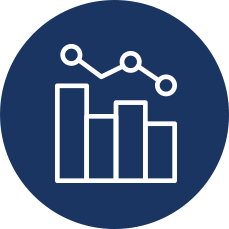Optimizing Existing Processes to Improve Transparency and Collaboration
In many organizations, finance and accounting are rife with manual processes. Holding on to paper forms, emails, Excel spreadsheets, and siloed software can be familiar and comfortable, but it also slows down your team and makes their jobs much harder than they need to be.
Implementing finance automation software can save your team time and trouble by:
- Eliminating miscommunications
- Automating manual processes
- Ensuring Accuracy
If you want to gain buy-in from your team, here are several benefits that finance automation software can bring to your business.

Data Integrity
Manual business processes are prone to human error, and those mistakes waste time and money. The number of hours needed to do the work and track down accidents from manual data entry can be reduced or eliminated by having the right system in place.
Finance automation software can create thousands of entries in seconds, with no real risk of the data being mishandled. And machine learning algorithms can systematically identify anomalies in datasets and correct them.
When your financial data is accurate, you can use it to drive meaningful change and improve your bottom line.

Improved Efficiency
Automating manual, repetitive tasks saves time. After all, if someone (or something) else does the manual work your accounting team would typically do, people have more time on their hands for other tasks.
In many companies, the most significant time savings achieved by implementing finance automation software occur during the month-end close. Because your software records and helps facilitate the reconciliation process throughout the month, there’s often very little to reconcile. Employees may need to follow up on a handful of exceptions rather than checking each entry, but in most cases, most transactions can be matched using machine learning.
Additionally, teams can design forms, create workflows, and streamline existing processes so what’s usually done in days (or weeks) can be done in minutes.

Faster Approvals
Accounts payable and expense reports are significant sources of bottlenecks in many organizations. The sheer volume of payables and expenses makes tracking accounts payable and getting approvals for all disbursements slow and tedious.
With a finance automation solution, you can eliminate many manual aspects of accounts payable and expense reimbursement approvals, helping to streamline the process, avoid late fees, and provide greater visibility into invoice processing progress.

Greater Visibility
In addition to automating transaction matching, account reconciliations, journal entries, and other financial close processes, teams gain next-level visibility into their recurring accounting processes with real-time dashboards. This provides a high level of transparency into your financial data that isn’t available with spreadsheets.
Connected systems give you a more complete picture of your financials to identify fluctuations and problems much faster and make smarter business decisions.

Enhanced Flexibility
Anyone who remembers the days of desktop accounting software and floppy disks knows how much more flexible work is with cloud-based accounting software. Your accounting team can handle every important task anytime, anywhere, as long as they have a laptop or mobile device and an internet connection.
Modern accounting automation software tends to be cloud-based, so it can easily integrate with your ERP and other tools and applications. So if your team needs to quickly lookup a transaction or send a document to external auditors, they don’t need to worry about being in the office or having the file in front of them. Everything they need is available online.
Additionally, by automating highly-manual tasks, accountants have more time to work on ongoing projects or pitch in when additional help is needed.

Lower Levels of Risk
Inaccurate financial reporting negatively impacts an organization. Federal and state regulations, strict compliance standards, and investor scrutiny leave little wiggle room for errors or inaccuracies. And repeated financial reporting issues can result in fines, penalties, and damage to the company’s reputation.
Automating specific tasks…
- Reduces the risk of human error
- Increases accuracy
- Provides greater visibility and oversight
…into the entire financial reporting process.

Improved Collaboration
Automation improves integration between systems used by different departments, making it much easier for teams to work together.
For example, the accounting and finance team can regularly follow how money is being spent by a department or on a project and check in with the department head or project manager. This makes it easier to keep expenses from getting out of control and helps both departments anticipate when additional funding is necessary and reasonable.

Happier Employees
People tend to associate automation with job loss. After all, if computers can do the same work in less time, the company can hire fewer humans.
However, automation opens up more time for humans to do what computers can’t:
- Build relationships
- Think strategically
- Develop creative solutions to unstructured problems
And that’s what most accountants want to do. According to a survey from Robert Half, 41% of accountants say problem-solving gives them the most job satisfaction, and 17% cited making strategic recommendations for the business as their favorite task, compared to just 22% who chose to work with numbers.
With talent retention in the accounting world becoming a major problem, having a resource in place that reduces the amount of manual work without cutting corners leads to greater job satisfaction, efficiency, and work-life balance.

Seamless Data Retrieval
Not too long ago, if you wanted to retrieve a document or review a file, you may have had to go hunting in a storage room full of hundreds of files.
Automation and cloud-based accounting systems make it incredibly easy to locate virtually any file you need in seconds.
Suppose you receive a document digitally, such as a purchase order or credit card statement. In that case, your automation platform can automatically attach the document to the appropriate transaction or store it in the proper digital folder.
The Bottom Line: Ensuring Transparency and Eliminating Bottlenecks
As RPA and other automation tools evolve, they continue to improve the accuracy of accounting and financial reporting. This should be viewed as a positive development that will make everyone’s jobs more manageable rather than a threat.
As boards of directors and CEOs increasingly look to the accounting and finance teams to provide accurate, timely information, having all of the organization’s critical financial data at your fingertips is a must. Finance automation software is the way to ensure your organization can do just that.
